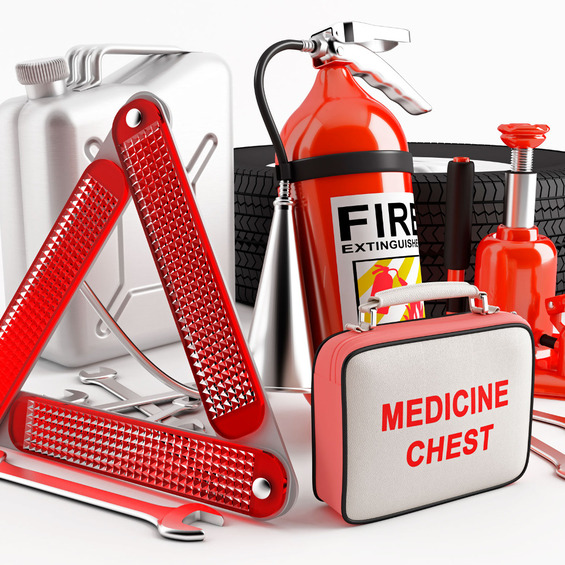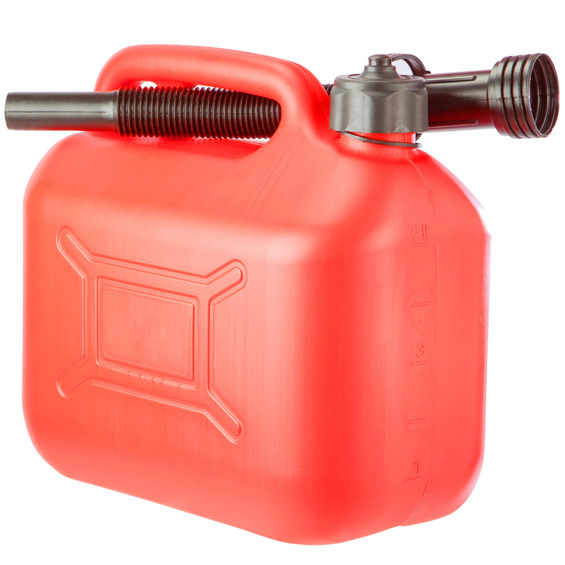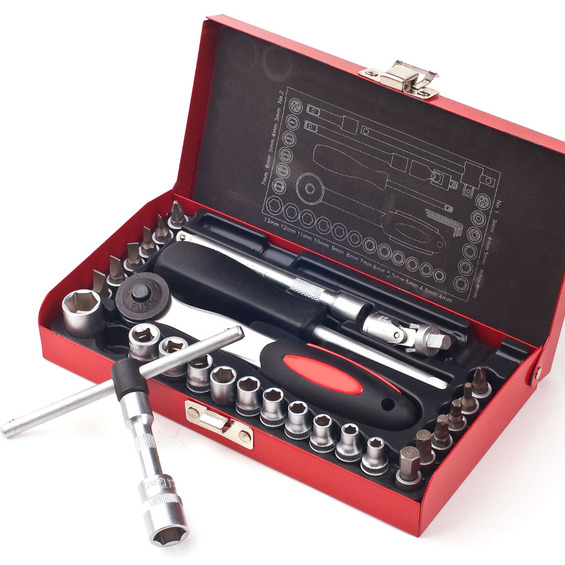
There are many different situations on the road, and sometimes, with one or another object, it is possible not only to deal with minimal losses, to deal with a small breakage that prevents movement, but also to save the life and health of himself or another driver in distress. The Road Traffic Regulations have a list of items to be with each motorist, but the list is not exhaustive, and the components in it can be of varying quality, cost and value.
The PDA requires the driver to carry only 3 items-a fire extinguisher, a first-aid kit and an emergency stop sign. In fact, a list of what can be of use to the driver is much more extensive
In addition to this mandatory list, drivers often carry other items that, based on their experience, can provide invaluable assistance in a given situation. The items can be divided into several categories of purpose and degree of necessity. Part of them does not make sense to carry with them if the trips are limited to "work-to-work", they are enough to be held under the arm to put them in the trunk before the journey. In addition, there is a seasonal fission, for example, a warm blanket is not necessary in the 30-degree heat, and the liquid for the fire of the fire is dangerous.
Mandatory set of motorist
HYDRA requires drivers to carry only three items: a first-aid kit, an emergency stop sign and a fire extinguisher. These things need to be in the event of an emergency, and the inspector checks them if you are going through a technical inspection at a point within the structure of the traffic police. In fact, however, even these items, except as an emergency stop sign, are controversial.

There is no doubt that there will be no doubt about the need to have a fire extinguisher and a first-aid kit. However, the same first-aid kit of the "new specimen", the contents of which are described in the relevant order of the Ministry of Health, which entered into force on 1 July 2010, raises many questions. According to the order, the first-aid kit should have a set of bandages of different widths, a set of plasters of the three types, sterile gauze napkins, dressing bag, hemorrhage, mouth-to-mouth, scissors, medical gloves, and instructions for the use of all these objects.
This strange, from the point of view of many motorists, was the result of the fact that the Ministry decided to take the path of rejection of all drugs. According to the theory, medicines can only be used by qualified specialists, but in the case of ambulance arrival sometimes it is necessary to wait long enough, so without painkillers the victims risk death from pain of pain. It is the decision to give up the drugs to the most heated arguments. Many motorists believe that in this case it is necessary to carry a syringe and a primitive analgesic (like analgin) in ampoules.
Even with such seemingly obvious points of the list as a fire extinguisher and a first-aid kit, in practice everything is not so simple ...
The fire extinguishers are also not easy. According to the instruction, this device shall be safe and extinguishers shall be considered to be of a powder type. Practice shows that for more or less effective use it is necessary to have a fire extinguisher of at least 4 kilos with a hose and a ratrude, and what is sold as part of multiple "motorists" (at best 2 kilograms of charge), the extinguishing of something is problematic, as it is often necessary to "roll" it out of the extinguisher several times in order to hit the engine fire. In this case the charge of a small fire extinguisher will simply not be sufficient.
Equipment
This is the second most important group of items that are good in the machine, as they help to emerge from the most common emergencies occurring during the movement.
The group can be divided into two sub-groups, a basic set of items and tools that may be needed at any time, and an extended list to be collected on the far road.

A kit that's good to have with you always: Distilled ignition (a distilled) ignition (") wiring"; a tow cable with a design load limit of not less than 5 tonnes (broad or steel); a basic set of tools (wrenches, a minimum allowing to be removed and placed at the place of the battery, a baton key, a set of heads); a spare wheel and a flat blade; a pump or a jack; a spare wheel or a compressor, distilled water, or a compressor with distilled water. non-mercuring liquid for the reservoir of the glass plug; small capacity with motor oil of the desired brand and viscosity; liquid for ACPR (or oil for checkpoint, bridges, depending on the type of motor vehicle); a small fuses for the oil-filling; a set of fuses; a set of lamps; a lamp for headlamps (at least the passing beam); a lamp working from the cigarette lighter; a lamp working from the cigarette lighter; working gloves; a working glove; a working glove; a folding knife; a rag; a rag; a water can be used for dry cleaning of hands; a tool for dry cleaning of hands; a tool for dry cleaning of hands; a tool for dry cleaning of hands; a tool for dry cleaning of hands; a tool for dry cleaning of hands; a tool for dry cleaning of hands; a tool for dry cleaning of hands; a brush with a scraper to clean snow and frost the glass tester to find the leak in the power grid; defrosting the locks.
- wires for charging another vehicle, so-called "wires";
- tow cable with a design limit of not less than 5 tonnes (broad or steel);
- A basic set of tools (wrenches, at a minimum, to remove and embody battery terminals, column keys, candle-key, pliers, and a flat-blade screwdriver, a set of heads);
- a spare wheel and a jack;
- A pump or compressor running from the cigarette lighter;
- Antifreeze of the same mark as in the cooling system of your car;
- Distilled water;
- unfreezing liquid for the glass washer;
- Small capacity with motor oil of the required make and viscosity;
- liquid for ACPR (or oil for checkpoint, bridges, depending on the type of car);
- small oil funnel or anti-freeze vortex;
- Fuses;
- A set of candles;
- Lamps for headlamps (at least passing beam);
- A lamp working from the cigarette lighter, and it is desirable to have another small light on batteries;
- A waiting paper for the cleaning of contacts.
- Working gloves;
- A folding knife;
- a rag
- Water jerricans;
- a tool for dry cleaning;
- A brush with a scraper to clean the snow and inea with glass;
- Tester to find leakage of current on the power grid;
- Defrosting the locks.

Add another one to this list. It lists the items that have to be taken in the future: A tank can be used to fill a tank or a single funnel with a large cork and a long corrugated tube; old clothes (on the far side of the road, the possibility of the need for unforeseen repairs increase and the climatic conditions may be unfavourable. It is best to take a warm old jacket that will protect against cold, mosquitoes, rain, etc.; axe; shovel; paper and liquid for retail; a bottle of mineralgs; charging for the telephone (and even better than charging an old but pre-charged spare telephone); an old sheet for a transaction.
- A gas canister of the right mark and a filler in the tank or a separate funnel with a large rail and a long corrugated tube;
- Old clothes (on the far road the possibility of the need for unforeseen repairs are increasing and climatic conditions may be unfavourable. It is best to take a warm old jacket that protects against cold, mosquitoes, rain, etc.);
- axe;
- Sappery shovel;
- Retail paper and fluid;
- A bottle of mineral water;
- Phone charger (even better than charging old, but precharged emergency phone);
- Isolent;
- the jets for the transaction.

The road collection can be discussed indefinitely, as much depends on the time of year during which travel, region, climate and so on. However, guided by the indicative basic list, one can be sure that most of the standard trouble will be overcome by its forces.









